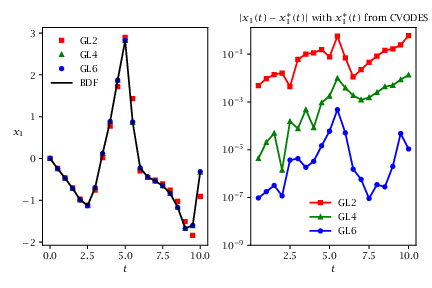1
2
3
4
5
6
7
8
9
10
11
12
13
14
15
16
17
18
19
20
21
22
23
24
25
26
27
28
29
30
31
32
33
34
35
36
37
38
39
40
41
42
43
44
45
46
47
48
49
50
51
52
53
54
55
56
57
58
59
60
61
62
63
64
65
66
67
68
69
70
71
72
73
74
75
76
77
78
79
80
81
82
83
84
85
86
87
88
89
90
91
92
93
94
95
96
97
98
99
100
101
102
103
104
105
106
107
108
109
110
111
112
113
114
115
116
117
118
119
120
121
122
123
124
125
126
127
128
129
130
131
132
133
134
135
136
137
138
139
140
141
142
143
144
145
146
147
148
149
150
151
152
153
154
155
156
157
158
159
160
161
162
163
164
165
166
167
168
169
170
171
172
173
174
175
176
177
178
179
180
181
182
183
184
185
186
187
188
189
190
191
192
193
194
195
196
197
198
199
200
201
202
203
204
205
206
207
208
209 | % Simulates a system using Gauss-Legendre collocation schemes of order 2, 4 and 6
% Joel Andersson, UW Madison 2017
% Declare model variables
x1 = casadi.SX.sym('x1');
x2 = casadi.SX.sym('x2');
u = casadi.SX.sym('u');
% Model equations
x1_dot = (1-x2^2)*x1 - x2 + u;
x2_dot = x1;
% Objective function (integral term)
quad = x1^2 + x2^2 + u^2;
% Dimensions
nx = 2;
np = 1;
% Test value
x_test = [0; 1];
u_test = 0.5;
% End time
T = 10;
% Nunber of integrator steps
N = 20;
% Time step
dt = T/N;
% Time grid for plotting
tgrid = linspace(0, T, N+1);
% Simulate with collocation, order 1, 2 and 3
for d=[1,2,3]
% Gauss-Legendre points
switch d
case 1
tau_root = [0, 0.5];
case 2
tau_root = [0, 0.5-sqrt(3)/6, 0.5+sqrt(3)/6];
case 3
tau_root = [0, 0.5-sqrt(15)/10, 0.5, 0.5+sqrt(15)/10];
otherwise
error('order not supported');
end
% Degree of interpolating polynomial
d = numel(tau_root)-1;
% Coefficients of the collocation equation
C = zeros(d+1,d+1);
% Coefficients of the continuity equation
D = zeros(d+1, 1);
% Coefficients of the quadrature function
B = zeros(d+1, 1);
% Construct polynomial basis
for j=1:d+1
% Construct Lagrange polynomials to get the polynomial basis at the collocation point
coeff = 1;
for r=1:d+1
if r ~= j
coeff = conv(coeff, [1, -tau_root(r)]);
coeff = coeff / (tau_root(j)-tau_root(r));
end
end
% Evaluate the polynomial at the final time to get the coefficients of the continuity equation
D(j) = polyval(coeff, 1.0);
% Evaluate the time derivative of the polynomial at all collocation points to get the coefficients of the continuity equation
pder = polyder(coeff);
for r=1:d+1
C(j,r) = polyval(pder, tau_root(r));
end
% Evaluate the integral of the polynomial to get the coefficients of the quadrature function
pint = polyint(coeff);
B(j) = polyval(pint, 1.0);
end
% Continuous-time dynamics
f = casadi.Function('f', {[x1;x2], u}, {[x1_dot;x2_dot], quad},...
{'x','p'}, {'ode','quad'});
% Start with an empty nonlinear system of equations
w = {};
w0 = {}; % guess for w
rhs = {};
% x0, p are parameters of the Newton solver
X0 = casadi.MX.sym('X0', nx);
P = casadi.MX.sym('P', np);
% State vector at collocation points are unknowns
Xj = cell(1,d);
for j=1:d
Xj{j} = casadi.MX.sym(['X_' num2str(j)], nx);
w{end+1} = Xj{j};
w0{end+1} = zeros(nx,1);
end
% Get expressions for the state derivatives at all collocation points
% from differentiating the polynomials
Xj_dot = cell(1,d);
for j=1:d
Xj_dot{j} = C(1,j+1)*X0;
for r=1:d
Xj_dot{j} = Xj_dot{j} + C(r+1,j+1)*Xj{r};
end
end
% Evaluate the function at all the collocation points
ode_j = cell(1,d);
quad_j = cell(1,d);
for j=1:d
[ode_j{j}, quad_j{j}] = f(Xj{j}, P);
end
% Gather collocation equations
for j=1:d
rhs{end+1} = dt*ode_j{j} - Xj_dot{j};
end
% Get an expression for the state at the end of the interval
Xf = D(1)*X0;
for j=1:d
Xf = Xf + D(j+1)*Xj{j};
end
% Get an expression for the quadrature
Qf = 0;
for j=1:d
Qf = Qf + B(j+1)*quad_j{j}*dt;
end
% Concatenate nonlinear equations and variables
w = vertcat(w{:});
w0 = vertcat(w0{:});
rhs = vertcat(rhs{:});
% Create a rootfinding solver object
rfp = casadi.Function('rfp', {w, X0, P}, {rhs, Xf, Qf},...
{'w0', 'x0', 'p'}, {'w', 'xf', 'qf'});
solver = casadi.rootfinder('solver', 'newton', rfp);
% Simulate
x_sim = x_test;
q_sim = 0;
w_sim = w0;
for k=1:N
sol = solver('x0', x_sim(:, end), 'p', u_test, 'w0', w_sim);
x_sim = [x_sim, full(sol.xf)];
q_sim = [q_sim, q_sim(:,end) + full(sol.qf)];
w_sim = sol.w;
end
switch d
case 1
x_gl2 = x_sim;
q_gl2 = q_sim;
case 2
x_gl4 = x_sim;
q_gl4 = q_sim;
case 3
x_gl6 = x_sim;
q_gl6 = q_sim;
otherwise
error('order not supported');
end
end
% Compare with CVODES with high accuracy
prob = struct('x', [x1;x2], 'p', u, 'ode', [x1_dot;x2_dot], 'quad', quad);
opts = struct('grid', tgrid, 'output_t0', true, 'reltol', 1e-13, 'abstol', 1e-13);
integ = casadi.integrator('integ', 'cvodes', prob, opts);
sol = integ('x0', x_test, 'p', u_test);
x_cvodes = full(sol.xf);
q_cvodes = full(sol.qf);
% Plot the solution
figure();
clf;
% Plot x_1(t)
subplot(1,2,1)
hold on;
grid on;
plot(tgrid, x_gl2(1,:), 'r*-');
plot(tgrid, x_gl4(1,:), 'gx-');
plot(tgrid, x_gl6(1,:), 'bo-');
plot(tgrid, x_cvodes(1,:), 'k-');
xlabel('t')
title('Simulation x_1(t)')
legend('GL2', 'GL4', 'GL6', 'BDF', 'Location', 'northwest')
% Plot error
subplot(1,2,2)
hold on;
grid on;
semilogy(tgrid(2:end), abs(x_gl2(1,2:end)-x_cvodes(1,2:end)), 'r*-');
semilogy(tgrid(2:end), abs(x_gl4(1,2:end)-x_cvodes(1,2:end)), 'gx-');
semilogy(tgrid(2:end), abs(x_gl6(1,2:end)-x_cvodes(1,2:end)), 'bo-');
xlabel('t')
title('|x_1(t) - x^*_1(t)| with x^*_1(t) from CVODES')
legend('GL2','GL4','GL6','Location', 'south')
|
